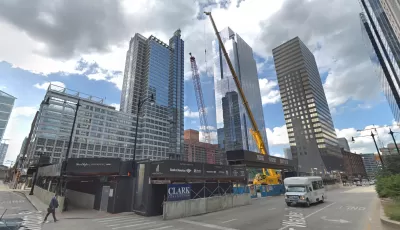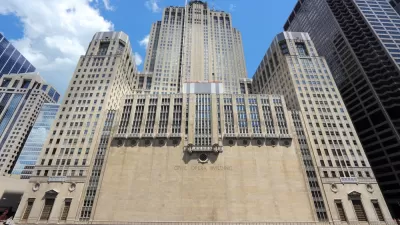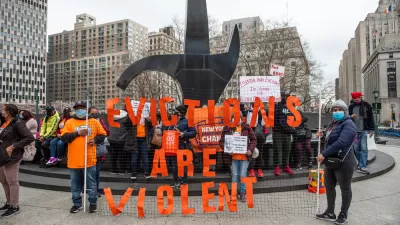A riverfront revival was well underway in Chicago. Then the pandemic hit. How can a splashy new downtown commercial development expect to fare in Covid's world?

The Bank of America Tower recently opened on the Chicago riverfront as the tallest new office building in the city in 30 years by topping out at 816 feet.
With Chicago's central business district (CBD) getting hammered during the pandemic, Blair Kamin offers three reasons to pause and take notice of the new building.
For one, the Bank of America Tower "represents a strong sign of confidence" in the CBD despite its current travails. For another reason, the building will add a $25 million boost in property tax revenue to a city government that is, similar to the CBD, suffering the effects of the economic downturn caused by the pandemic.
Finally, "The modernist design, a mix of bold structural drama, attractive public spaces and reflective-glass banality, will leave its mark on downtown long after the COVID-19 pandemic has passed," writes Kamin.
The new building is located on a site described by Kamin as high profile and transit oriented at 110 N. Wacker Drive. Prominently, the new building is the latest sign of how the Chicago River has become a focal point of civic and commercial life.
"Skyscrapers, like the neighboring Civic Opera Building at 20 N. Wacker, once turned their back on the polluted river. No more," writes Kamin.
A key question about the building's success still looms, however, given the current state of the economy and the large numbers of office workers staying home during the pandemic—whether by choice or by necessity of unemployment. The building's lead tenant, Bank of America, was expecting more than 2,000 employees to be working in the building. Currently, only 200 employees are reporting to the office.
FULL STORY: City’s tallest office building in 30 years opens along Chicago River, mixing drama and banality

Planetizen Federal Action Tracker
A weekly monitor of how Trump’s orders and actions are impacting planners and planning in America.

Congressman Proposes Bill to Rename DC Metro “Trump Train”
The Make Autorail Great Again Act would withhold federal funding to the system until the Washington Metropolitan Area Transit Authority (WMATA), rebrands as the Washington Metropolitan Authority for Greater Access (WMAGA).

The Simple Legislative Tool Transforming Vacant Downtowns
In California, Michigan and Georgia, an easy win is bringing dollars — and delight — back to city centers.

The States Losing Rural Delivery Rooms at an Alarming Pace
In some states, as few as 9% of rural hospitals still deliver babies. As a result, rising pre-term births, no adequate pre-term care and "harrowing" close calls are a growing reality.

The Small South Asian Republic Going all in on EVs
Thanks to one simple policy change less than five years ago, 65% of new cars in this Himalayan country are now electric.

DC Backpedals on Bike Lane Protection, Swaps Barriers for Paint
Citing aesthetic concerns, the city is removing the concrete barriers and flexposts that once separated Arizona Avenue cyclists from motor vehicles.
Urban Design for Planners 1: Software Tools
This six-course series explores essential urban design concepts using open source software and equips planners with the tools they need to participate fully in the urban design process.
Planning for Universal Design
Learn the tools for implementing Universal Design in planning regulations.
Smith Gee Studio
City of Charlotte
City of Camden Redevelopment Agency
City of Astoria
Transportation Research & Education Center (TREC) at Portland State University
US High Speed Rail Association
City of Camden Redevelopment Agency
Municipality of Princeton (NJ)





























